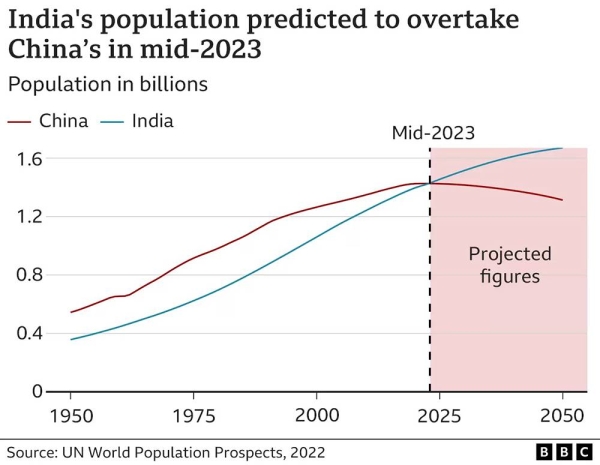
India is expected to overtake China as the world’s most populous country with almost 3 million more people by the middle of this year, according to UN figures.
The State of World Population 2023 report by the United Nations Population Fund (UNFPA) estimates India’s population will be 1.4286 billion by the end of June, compared with China’s 1.4257 billion.
The US is a distant third, with an estimated population of 340 million people by the end of June. The data in the report is based on information available up to February.
Population experts using previous data from the UN have projected India’s population would surpass China’s in April, but the global body’s latest report did not specify a date.
UN population officials have said it is not possible to pinpoint a date because of uncertainty about the data from India and China, as the last census in the former was in 2011 and the next, which was due in 2021, was delayed by the Covid-19 pandemic.
Although the two countries combined will account for more than a third of the estimated 8.045 billion people in the world, population growth in both has been slowing, albeit much faster in China than in India.
Last year, China’s population shrank for the first time in six decades. The decrease is expected to mark the beginning of a long period of population decline in China, with profound implications for its economy and the world.
A spokesperson for the Chinese foreign ministry said population dividends did not only depend on quantity but also on quality. “Population is important but talents are also important … … China has taken active measures to respond to population ageing,” Wang Wenbin said on Wednesday.
“As Premier Li Qiang pointed out, our population dividend has not disappeared. Our talent dividend is booming, and the impetus for development is strong,” he added.
There was no official reaction from India to the data, with a federal minister saying it was not discussed at a cabinet meeting on Wednesday.
India’s annual population growth has averaged 1.2% since 2011, down from 1.7% in the previous decade, government data shows.
A public survey carried out by UNFPA found the most commonly held opinion in India, as well as in Brazil, Egypt and Nigeria, was that the population in each country “was too large and fertility rates were too high”, the report said.
“The Indian survey findings suggest that population anxieties have seeped into large portions of the general public,” Andrea Wojnar, the agency’s India representative, said.
“Yet population numbers should not trigger anxiety or create alarm. Instead, they should be seen as a symbol of progress, development, and aspirations if individual rights and choices are being upheld.”
India had done many things right in tackling population growth, said Poonam Muttreja, the executive director at the Population Foundation of India, a non-profit organisation. “At the same time, we need to make sure that girls and women are not pushed into early marriages and pregnancies, which limit their aspirations,” she added.












